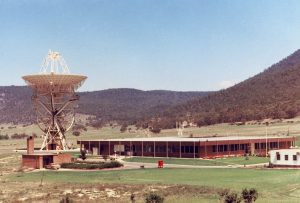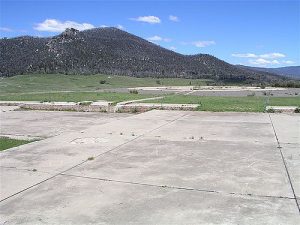The below provides a compact history, by timeline, of the Station.
1963 Survey and site works begin
1964 Building construction begins
1965 Equipment installation starts while building construction is completed.
Late 1965 Limited tracking operations started while equipment installation completed
Feb 1966 Official opening ceremony
1966 Full tracking operations underway. Orroral has 3 transmitting antennas and 4 receiving antennas. It has 4 telemetry receiving and tracking systems.
1966 Minitrack system moved from Woomera to Orroral. Minitrack begins tracking from Orroral in late 1966. Orroral now has 3 transmitting systems and 5 receiving/tracking systems.
1966 Full tracking operations with between 30 and sometimes up to more than 70 tracks (passes) per day. The first fully versatile digital computer is installed for support of the Orbiting Astronomical Observatory project. During 1967 Orroral tracks Australia’s first satellite. WRESAT is launched from Woomera in South Australia.
1968 The access roads to Orroral are flooded on several occasions but tracking operations continue without interruption

1974 The access roads to Orroral are flooded on several occasions but tracking operations continue without interruption. In August there is one occasion of very severe flooding. After the station had been isolated for about 3 days supplies are running out. Relief is arranged by the use of RAAF helicopters. New staff and supplies are flown in and the staff are flown out. Orroral continued tracking throughout the flood period. Orroral staff levels reach over 200. Orroral is the largest tracking station outside of the United States. Construction of extensions to the operations building to support manned space flight. Another antenna is added to Orroral – a 9 metre dish for both transmitting and receiving. Orroral now has 4 transmitting systems and 6 receiving/tracking systems.
1975 Orroral tracks to Apollo-Soyuz joint USSR-Unites States mission. A laser tracking system is constructed near the Minitrack site. Orroral can now track up to 7 spacecraft at once. Orroral has taken over tracking of manned spacecraft from Honeysuckle Creek tracking station.
Late 1976 A major upgrade is made to Orroral’s 26 Metre antenna. It can now additionally receive the S-Band radio frequencies and track manned spacecraft. Orroral takes over tracking the scientific packages left on the Moon (ALSEP)
1977 The operations room is remodelled and new equipment installed for the Digital Data Processing System (DDPS) to improve tracking operations and data flow back to control centres in the United States.
30 Sept. 1977 Orrroral switches off the experiment packages left on the Moon (ALSEP).
1977 Two antennas are installed to track radio signals from the planet Jupiter.
1981 Orroral tracks the first orbital flight of the Space Shuttle. John Young and Bob Crippen are on board the ‘Columbia’. Later in the year the astronauts visit Orroral and present awards. Another antenna is installed – a 6 metre dish S-Band command antenna. Orroral can now command up to 5 spacecraft and track up to 7 spacecraft at once.
1982 Orroral is surrounded by bushfires/ Firefighting helicopters and trucks use the station as a base. Tracking staff travel to the station on specially protected roads.
1983 Staff from Orroral carry out the first official amateur radio experiment with the space shuttle during the STS-9 flight. They connect the space shuttle back to Houston with using any NASA systems.
1984 Orroral’s last space shuttle track is STS-14 launched 8 November. Orroral’s last tracking operation is on 21 December.
1985 31 January the station is officially closed. There is no ceremony, saddened staff simply walk away. Equipment dismantling and removal is done.
1986 Although there had been proposals to preserve some of the site and equipment, nothing is done to preserve anything.
1987 The Canberra Times documents severe vandalism at Orroral.
1992 The damage from vandalism is so severe that the site is bulldozed. Only some foundations are left to mark the places of the buildings and structures of what was once the largest tracking station in the world outside of the United States.



